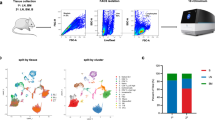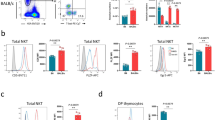Abstract
AMONG thymus-derived (T) lymphocytes of the mouse, several functionally distinct subsets may be identified (for review, see ref. 1). Early studies have shown synergy in graft-versus-host reactions of different populations of lymphoid cells2, and in vitro studies have demonstrated interactions between cells from anti-lymphocyte serum-treated mice (T1 cells) and adult thymectomised mice (T2 cells)3. A similar synergy has been observed in the generation of T helper and T suppressor cells in vitro4. Clearer definition of the subsets of T cells interacting in the induction of immune responses has come from the use of allo-antisera recognising differentiation antigens on T cells. In particular, the use of antisera to the Ly series of antigens5 has enabled the separation of amplifying (MLR) cells from killer cells6. Similarly in the humoral response helper T cells can be distinguished from suppressor T cells7. In this report, we show that killer and suppressor T cells, both generated in vitro and carrying the Ly-2 and 3 antigens can also be separated using antisera to surface antigenic markers. We also present data suggesting that suppressor cells of similar phenotype may have an important function in vivo in the immune response.
This is a preview of subscription content, access via your institution
Access options
Subscribe to this journal
Receive 51 print issues and online access
$199.00 per year
only $3.90 per issue
Buy this article
- Purchase on Springer Link
- Instant access to full article PDF
Prices may be subject to local taxes which are calculated during checkout
Similar content being viewed by others
References
Beverley, P. C. L., in T and B Lymphocytes in Immune Recognition (edit. by Loor, F., and Roelants, G.) (Wiley, Chichester, UK, in the press).
Cantor, H., and Asofsky, R., J. exp. Med., 131, 235–246 (1970).
Simpson, E., and Cantor, H., Eur. J. Immun., 1, 337–343 (1975).
Feldmann, M., Erb, P., Kontiainen, S., and Dunkley, M., in Membrane Receptors of Lymphocytes (edit. by Seligmann, M., Preud'homme, J. L., and Kourilsky, F. M.), 305–310 (North-Holland, Amsterdam, 1975).
Boyse, E. A., Myazawa, M., Aoki, T., and Old, L. J., Proc. R. Soc., B 170, 175–193 (1968).
Cantor, H., and Boyse, E. A., J. exp. Med., 141, 1389–1399 (1975).
Feldmann, M., Beverley, P. C. L., Dunkley, M., and Kontiainen, S., Nature, 258, 614–616 (1975).
Kontiainen, S., and Feldmann, M., Eur. J. Immun. (in the press).
Wagner, H., and Feldmann, M., Cell. Immun., 4, 39–50 (1972).
Kontiainen, S., and Feldmann, M., Nature new Biol., 245, 285–286 (1973).
Simpson, E., Gordon, R., Taylor, M., Mertin, J., and Chandler, P., Eur. J. Immun., 5, 451–455 (1975).
Scheid, M., Boyse, E. A., Carswell, E. A., and Old, L. J., J. exp. Med., 135, 938–955 (1972).
Hammerling, G. J., Deak, B. D., Mauve, D., Hammerling, U., and McDevitt, H. O., Immunogenetics, 1, 68–81 (1974).
Klein, J., in Biology of the Mouse Histocompatibility Complex, 451 (Springer, Berlin, 1975).
Julius, M. H., Simpson, E., and Herzenberg, L. A., Eur. J. Immun., 3, 645–649 (1975).
Shiku, H., et al., J. exp. Med., 141, 227–241 (1975).
Hammerling, G. J., Black, S. J., Segal, S., and Eichmann, K., Proc. Tenth Leukocyte Culture Conf. (edit. by Eijvoogel, V. P., Roos, D. and Zeiljmaker, W. P.), 367–378 (Academic, New York and London, 1976).
Tada, T., Taniguchi, M., and Takemori, T., Transplant. Rev., 26, 106–129 (1975).
Sachs, D. H., and Cone, J. L., J. exp. Med., 138, 1289–1304 (1973).
Frelinger, J. A., Niederhuber, J. E., David, C. S., and Shreffler, D. C., J. exp. Med., 140, 1273–1284 (1974).
Cantor, H., and Boyse, E. A., J. exp. Med., 141, 1376–1389 (1975).
Cantor, H., Shen, F. W., and Boyse, E. A., J. exp. Med., 143, 1391–1401 (1976).
Vadas, M. A., et al., J. exp. Med. (in the press).
Author information
Authors and Affiliations
Rights and permissions
About this article
Cite this article
BEVERLEY, P., WOODY, J., DUNKLEY, M. et al. Separation of suppressor and killer T cells by surface phenotype. Nature 262, 495–497 (1976). https://doi.org/10.1038/262495a0
Received:
Accepted:
Issue Date:
DOI: https://doi.org/10.1038/262495a0
This article is cited by
-
Precursor and effector phenotypes of activated human T lymphocytes
Nature (1980)
-
Surface markers on the T cells that regulate cytotoxic T-cell responses
Immunogenetics (1980)
-
Absence of expression of IA antigen on human cytotoxic T cells
Immunogenetics (1980)
-
An Lyt differentiated thymocyte subpopulation detected by flow microfluorometry
Nature (1979)
-
Transfer of specific cytotoxic T lymphocytes protects mice inoculated with influenza virus
Nature (1978)
Comments
By submitting a comment you agree to abide by our Terms and Community Guidelines. If you find something abusive or that does not comply with our terms or guidelines please flag it as inappropriate.



